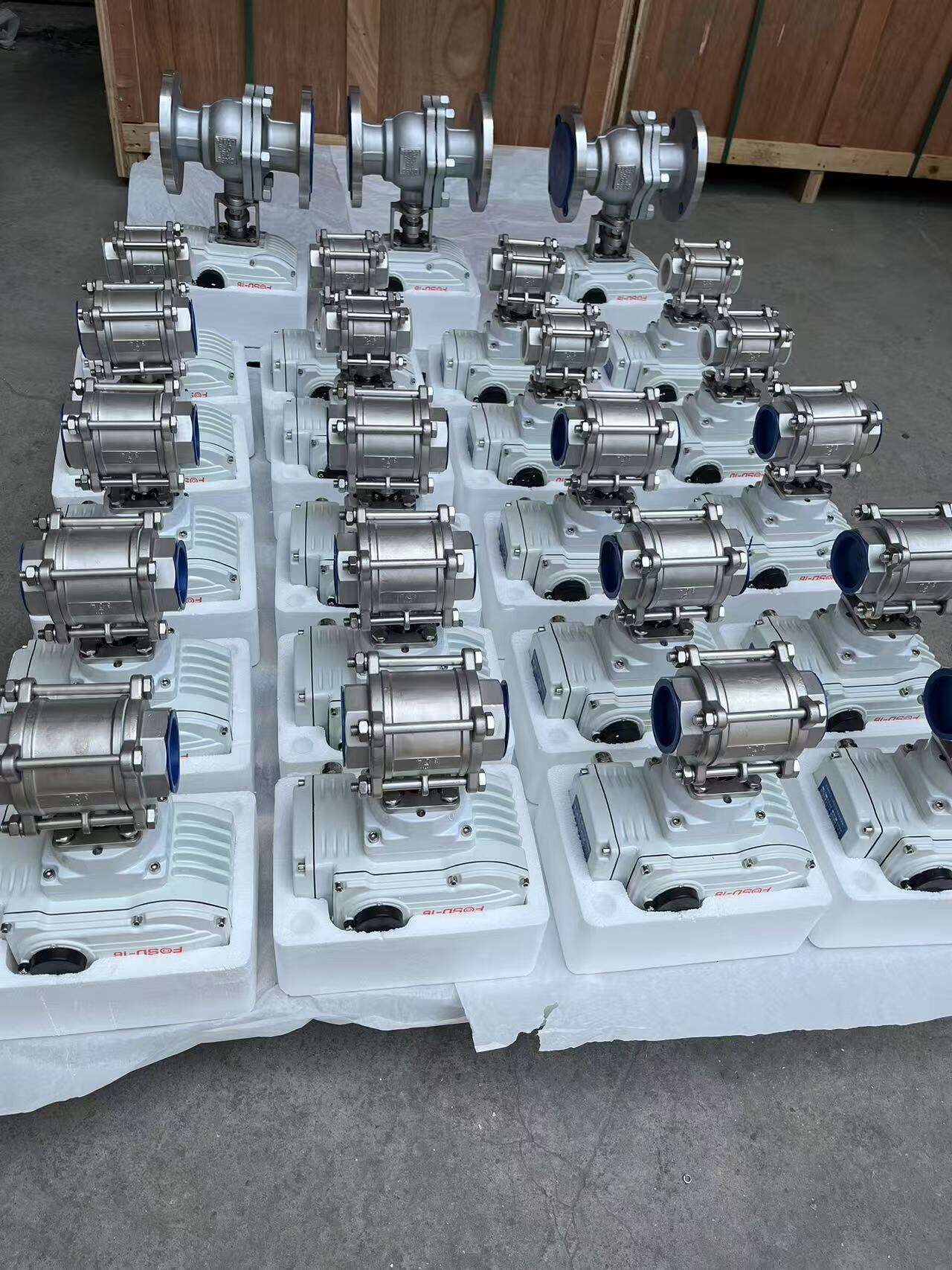Understanding the Electric Ball Valve System and Core Components
Key Components of an Electric Ball Valve: Actuator, Stem, Ball, and Seals
Electric ball valves rely on four main parts working together to function properly. At the heart of the system sits the electric actuator, which takes electricity and turns it into movement. Most models use either stepper or servo motors for this conversion process. When activated, the actuator sends rotational force down the stem, causing the ball inside to turn. The ball has a 90 degree hole through it that opens and closes to control how fluids pass through the valve. For sealing purposes, manufacturers often install PTFE or rubber-like materials around the moving parts. These seals keep everything tight even when dealing with high pressure situations, sometimes going up to 600 pounds per square inch. Meeting ASME B16.34 requirements means these valves can handle tough industrial conditions without leaking, making them reliable choices for critical systems where failure isn't an option.
How Control Signals Initiate Valve Movement in Automated Systems
Automated systems use 4-20 mA or 24 VDC signals from PLCs to initiate valve movement. Upon signal reception, the actuator’s gear train rotates the stem, completing full travel in 15–30 seconds for standard models. Industrial protocols like Modbus TCP provide position feedback, enabling closed-loop control essential for process stability.
Common Operational Principles Behind Electric Ball Valve Actuation
Electric ball valves rely on torque-based actuation, with actuators rated between 20–300 Nm depending on valve size. Dual safeguards—mechanical stops and Hall-effect sensors—prevent over-rotation. Fail-safe models use spring returns during power loss, while modulating types support 0–100% positioning for precise flow regulation.
Diagnosing and Resolving Valve Positioning Failures
Electric ball valve systems require precise coordination between mechanical parts and control signals. When positioning failures occur, a systematic approach helps isolate issues ranging from physical obstructions to electronic faults.
Valve cannot open or close completely — assessing mechanical obstruction and misalignment
Inspect for foreign particles or mineral buildup that restrict ball rotation. Misalignment between the actuator stem and valve shaft contributes to 31% of partial movement failures. Perform manual override tests to differentiate mechanical binding from control-related problems.
Role of limit switch malfunctions in incomplete valve travel
Limit switches stop actuator movement at full open/close positions. When faulty, valves often halt at 85–90% travel. Test switch continuity during cycling to verify proper engagement at endpoints.
Adjusting torque settings and recalibrating the actuator for full range motion
Excessive torque demands can trigger premature shutdown. Recalibrate according to manufacturer specifications to match system pressure requirements. After adjustment, confirm full 90-degree rotation over three operational cycles.
Controversy Analysis: When automation feedback masks actual valve position
A 2022 control valve study revealed that 18% of automated systems reported false position confirmations during mechanical failures. This underscores the importance of physically verifying valve position in safety-critical applications, even when electronic feedback appears normal.
Addressing Control Signal and Communication Failures
Control Signal Abnormalities and Their Impact on Electric Ball Valve Response
Voltage spikes, signal attenuation, or protocol mismatches disrupt communication between controllers and valves. According to the 2024 Fluid Systems Safety Report, signal anomalies cause 34% of delayed responses in automated pipelines. These are often misdiagnosed as mechanical issues but usually stem from degraded wiring or logic mismatches.
Testing Input Signals and Verifying PLC or DCS Output Integrity
To validate signal integrity:
- Measure mA output from PLC/DCS terminals during command execution
- Confirm compatibility between communication protocols (e.g., HART vs. Foundation Fieldbus)
- Check grounding continuity between control cabinet and actuator
A documented case showed that a 22μV ground potential difference caused erratic 4–20mA signals in offshore oil valves, leading to incorrect failure diagnoses.
Signal Present But Valve Not Actuating: Isolating Wiring Faults vs. Internal Circuit Failure
When signals reach terminal blocks without actuation:
- Wiring faults: Check conductor resistance; values above 5Ω per 100ft suggest corrosion
- Internal circuits: Use an oscilloscope to assess MOSFET switching on the actuator control board
Industrial surveys indicate that undetected wiring degradation accounts for 68% of signal-related failures, especially in humid environments.
Trend: Increasing Use of Smart Diagnostics to Detect Signal Loss Early
Modern electric ball valves feature integrated ICs that monitor signal patterns and predict failures 8–12 weeks in advance. One refinery reduced unplanned downtime by 41% after deploying valves with:
- Built-in Modbus/TCP packet inspection
- Dynamic impedance matching for long cable runs
- Real-time SNR (Signal-to-Noise Ratio) tracking
These smart systems enable proactive cable replacement based on electrical wear, moving maintenance from time-based to condition-based scheduling.
Identifying and Preventing Mechanical Blockages and Seal Failures
Valve Movement is Clogged or Unresponsive — Identifying Fluid-Borne Contaminants
Partial or no movement often results from particulate accumulation in the flow path, including scale, corrosion debris, or crystallized fluids. A 2022 ISA study found that 43% of unresponsiveness cases were due to sub-100-micron particles trapped at the ball-seal interface.
Stem Sticking During Reciprocating Motion: Wear, Corrosion, or Improper Lubrication?
Stem resistance causes delayed response or inconsistent torque. Key failure modes include:
| Failure Mode | Diagnostic Clues | Preventative Action |
|---|---|---|
| Corrosion | Surface pitting, galvanic reactions | Upgrade to 316L stainless steel |
| Wear | Polished stem areas, rising actuator current | Apply PTFE-based grease annually |
| Over-torque | Actuator slippage during operation | Set torque limiter to 80% of valve rating |
Leakage Along the Valve — Distinguishing Packing Leaks from Seat Degradation
External weeping indicates packing gland failure, often from degraded compressed graphite. Internal bypass suggests seat damage due to ball scoring. Use pressure-decay tests to identify the source:
- Packing leaks: 10% pressure drop within 5 minutes (valve closed)
- Seat leaks: Greater than 20% drop during static hold testing
Mechanical Wear and Thermal Cycling as Root Causes of Seal Failure
Repeated thermal expansion and contraction harden elastomer seals, reducing their ability to maintain contact during micro-movements. In high-cycle applications (≥50 actuations/day), conduct seal inspections every quarter.
Strategy: Implementing Upstream Filtration to Reduce Recurring Clogs
Install 40-micron duplex filters upstream to reduce particulate-related failures by 68%. For hydrocarbon systems, pair with magnetic traps to capture ferrous contaminants.
Ensuring Long-Term Reliability with Proactive Maintenance and Diagnostics
Maintenance and Diagnostic Practices for Electric Ball Valves as Preventive Safeguards
Regular inspections and lubrication significantly extend valve life. Scheduled checks of actuator torque and seal integrity reduce failure rates by 64% compared to reactive approaches. Technicians should focus on:
- Removing contaminants from internal chambers
- Testing electrical connection resistance
- Lubricating the actuator gear train per manufacturer guidelines
Step-by-Step Valve Maintenance and Repair Procedures for Field Technicians
Follow this sequence to minimize downtime:
- Lock out power and fully depressurize the system
- Confirm valve position using manual override
- Clean internal components with non-abrasive solvents
- Reassemble using specified torque values
Power Supply Issues Causing Voltage Fluctuations and Motor Stress
Unstable voltage accounts for 23% of early actuator failures. Verify:
- Stable supply within ±5% of nominal (24V/120V/240V)
- Grounding resistance below 1Ω
- Proper function of surge protection devices
Excess Noise or Heating from Actuator Indicating Drive Motor Failures
Grinding noises or housing temperatures above 60°C (140°F) indicate motor distress. Immediate diagnostics should include:
- Phase voltage imbalance assessment
- Rotational resistance measurement
- Insulation resistance testing (minimum 100MΩ required)
Thermal Imaging and IoT Sensors for Predictive Maintenance of Electric Actuators
Infrared cameras detect abnormal heat patterns before visible damage occurs. Combined with vibration sensors, they enable:
- Early detection of bearing wear (threshold: 0.05mm play)
- Real-time monitoring of lubrication effectiveness
- Analysis of power consumption trends
Strategy: Scheduled Replacement Intervals Based on Duty Cycle Analysis
Plants using duty-based maintenance report 41% fewer emergency repairs. Recommended replacement thresholds:
| Component | Moderate Duty | Heavy Duty |
|---|---|---|
| Valve Seals | 5M cycles | 1.2M cycles |
| Actuator Gears | 10M rotations | 2.5M rotations |
| Stem Bushings | 7M strokes | 1.8M strokes |
This data-driven strategy prevents unexpected failures while optimizing component lifespan and maintenance costs.
FAQ
What are the main components of an electric ball valve?
The main components of an electric ball valve include the actuator, stem, ball, and seals. These parts work together to regulate the flow through the valve.
Why is it important to address electrical signal abnormalities in electric ball valves?
Addressing electrical signal abnormalities is crucial as they often cause delayed responses or faulty operations in automated systems. Ignoring them can lead to inaccurate diagnoses and prolonged downtime.
How can valve positioning failures be diagnosed?
Valve positioning failures can be diagnosed by inspecting for obstructions, checking for misalignment between the actuator stem and valve shaft, and testing for limit switch malfunctions.
What causes excessive noise or heating in electric actuators?
Excessive noise or heating in electric actuators often indicates drive motor failures, which can be due to phase voltage imbalance, rotational resistance, or poor insulation.
How does predictive maintenance help with electric ball valves?
Predictive maintenance uses tools like infrared cameras and IoT sensors to identify potential issues before they become major problems, thereby reducing unplanned downtime and maintenance costs.
Table of Contents
- Understanding the Electric Ball Valve System and Core Components
-
Diagnosing and Resolving Valve Positioning Failures
- Valve cannot open or close completely — assessing mechanical obstruction and misalignment
- Role of limit switch malfunctions in incomplete valve travel
- Adjusting torque settings and recalibrating the actuator for full range motion
- Controversy Analysis: When automation feedback masks actual valve position
-
Addressing Control Signal and Communication Failures
- Control Signal Abnormalities and Their Impact on Electric Ball Valve Response
- Testing Input Signals and Verifying PLC or DCS Output Integrity
- Signal Present But Valve Not Actuating: Isolating Wiring Faults vs. Internal Circuit Failure
- Trend: Increasing Use of Smart Diagnostics to Detect Signal Loss Early
-
Identifying and Preventing Mechanical Blockages and Seal Failures
- Valve Movement is Clogged or Unresponsive — Identifying Fluid-Borne Contaminants
- Stem Sticking During Reciprocating Motion: Wear, Corrosion, or Improper Lubrication?
- Leakage Along the Valve — Distinguishing Packing Leaks from Seat Degradation
- Mechanical Wear and Thermal Cycling as Root Causes of Seal Failure
- Strategy: Implementing Upstream Filtration to Reduce Recurring Clogs
-
Ensuring Long-Term Reliability with Proactive Maintenance and Diagnostics
- Maintenance and Diagnostic Practices for Electric Ball Valves as Preventive Safeguards
- Step-by-Step Valve Maintenance and Repair Procedures for Field Technicians
- Power Supply Issues Causing Voltage Fluctuations and Motor Stress
- Excess Noise or Heating from Actuator Indicating Drive Motor Failures
- Thermal Imaging and IoT Sensors for Predictive Maintenance of Electric Actuators
- Strategy: Scheduled Replacement Intervals Based on Duty Cycle Analysis
-
FAQ
- What are the main components of an electric ball valve?
- Why is it important to address electrical signal abnormalities in electric ball valves?
- How can valve positioning failures be diagnosed?
- What causes excessive noise or heating in electric actuators?
- How does predictive maintenance help with electric ball valves?



